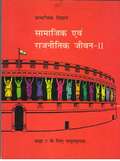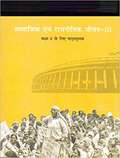- Table View
- List View
Samaja Vignana Bhaga-2 class 7 - Karnataka Board: ಸಮಾಜ ವಿಜ್ಞಾನ, ಭಾಗ - 2 ಏಳನೇ ತರಗತಿ
by Karnataka Patyapustaka Sanghaಇದು ಏಳನೇ ತರಗತಿಯ ಸಮಾಜ ವಿಜ್ಞಾನ, ಭಾಗ - 2 ವಿದ್ಯಾರ್ಥಿಗಳಿಗೆ ಈ ಶೈಕ್ಷಣಿಕ ಪುಸ್ತಕವು ಉಪಯುಕ್ತವಾಗಿದೆ.
Samaja Vignana Bhaga-2 class 8 - Karnataka Board: ಸಮಾಜ ವಿಜ್ಞಾನ, ಭಾಗ - 2 ಎಂಟನೇ ತರಗತಿ
by Karnataka Patyapustaka Sanghaಇದು ಎಂಟನೇ ತರಗತಿಯ ಸಮಾಜ ವಿಜ್ಞಾನ, ಭಾಗ - 2 ವಿದ್ಯಾರ್ಥಿಗಳಿಗೆ ಈ ಶೈಕ್ಷಣಿಕ ಪುಸ್ತಕವು ಉಪಯುಕ್ತವಾಗಿದೆ.
Samaja Vignana Bhaga-2 class 9 - Karnataka Board: ಸಮಾಜ ವಿಜ್ಞಾನ, ಭಾಗ - 2 ಒಂಬತ್ತನೇ ತರಗತಿಯ
by Karnataka Patyapustaka Sanghaಇದು 9ನೇ ತರಗತಿಯ ಸಮಾಜ ವಿಜ್ಞಾನ, ಭಾಗ - 2 ವಿದ್ಯಾರ್ಥಿಗಳಿಗೆ ಈ ಶೈಕ್ಷಣಿಕ ಪುಸ್ತಕವು ಉಪಯುಕ್ತವಾಗಿದೆ.
Samaja Vignana Part-1 class 10 - Karnataka Board: ಸಮಾಜ ವಿಜ್ಞಾನ ಭಾಗ -1 ಹತ್ತನೇ ತರಗತಿ
by Karnataka Patyapustaka Sanghaಇದು ಹೊಸ ಶಿಕ್ಷಣ ನೀತಿಯ ಪ್ರಕಾರ ಕರ್ನಾಟಕ ಪಠ್ಯ ಪುಸ್ತಕ ಸೊಸೈಟಿಯಿಂದ ಸಮಾಜ ವಿಜ್ಞಾನ ಭಾಗ -1 ಹತ್ತನೇ ತರಗತಿಯ ಕನ್ನಡ ಮಾಧ್ಯಮ ವಿದ್ಯಾರ್ಥಿಗಳಿಗೆ ಶೈಕ್ಷಣಿಕ ಪುಸ್ತಕವಾಗಿದೆ.
Samaja Vignana Part-1 class 6 - Karnataka Board: ಸಮಾಜ ವಿಜ್ಞಾನ ಭಾಗ- 1 ಆರನೇ ತರಗತಿ
by Karnataka Patyapustaka Sanghaಇದು ಹೊಸ ಶಿಕ್ಷಣ ನೀತಿಯ ಪ್ರಕಾರ ಕರ್ನಾಟಕ ಪಠ್ಯ ಪುಸ್ತಕ ಸೊಸೈಟಿಯಿಂದ ಸಮಾಜ ವಿಜ್ಞಾನ ಭಾಗ- 1 ಆರನೇ ತರಗತಿಯ ಕನ್ನಡ ಮಾಧ್ಯಮ ವಿದ್ಯಾರ್ಥಿಗಳಿಗೆ ಶೈಕ್ಷಣಿಕ ಪುಸ್ತಕವಾಗಿದೆ.
Samaja Vignana Part-1 class 8 - Karnataka Board: ಸಮಾಜ ವಿಜ್ಞಾನ ಭಾಗ -1 ಎಂಟನೇ ತರಗತಿ
by Karnataka Patyapustaka Sanghaಇದು ಹೊಸ ಶಿಕ್ಷಣ ನೀತಿಯ ಪ್ರಕಾರ ಕರ್ನಾಟಕ ಪಠ್ಯ ಪುಸ್ತಕ ಸೊಸೈಟಿಯಿಂದ ಎಂಟನೇ ತರಗತಿಯ ಕನ್ನಡ ಮಾಧ್ಯಮ ವಿದ್ಯಾರ್ಥಿಗಳಿಗೆ ಶೈಕ್ಷಣಿಕ ಪುಸ್ತಕವಾಗಿದೆ.
Samaja Vignana Part-1 class 9 - Karnataka Board: ಸಮಾಜ ವಿಜ್ಞಾನ ಭಾಗ -1 ಒಂಬತ್ತನೇ ತರಗತಿ
by Karnataka Patyapustaka Sanghaಇದು ಹೊಸ ಶಿಕ್ಷಣ ನೀತಿಯ ಪ್ರಕಾರ ಕರ್ನಾಟಕ ಪಠ್ಯ ಪುಸ್ತಕ ಸೊಸೈಟಿಯಿಂದ ಒಂಬತ್ತನೇ ತರಗತಿಯ ಕನ್ನಡ ಮಾಧ್ಯಮ ವಿದ್ಯಾರ್ಥಿಗಳಿಗೆ ಶೈಕ್ಷಣಿಕ ಪುಸ್ತಕವಾಗಿದೆ.
Samaja Vignana Part-2 class 10 - Karnataka Board: ಸಮಾಜ ವಿಜ್ಞಾನ ಭಾಗ-2 ಹತ್ತನೇ ತರಗತಿ
by Karnataka Patyapustaka Sanghaಇದು ಹೊಸ ಪಠ್ಯಕ್ರಮದ ಪ್ರಕಾರ ಸಮಾಜ ವಿಜ್ಞಾನ ಭಾಗ-2 ಹತ್ತನೇ ತರಗತಿಯ ಕನ್ನಡ ಮಾಧ್ಯಮ ವಿದ್ಯಾರ್ಥಿಗಳಿಗೆ ಈ ಶೈಕ್ಷಣಿವು ಮಾರ್ಗದರ್ಶಿಯಾಗಿದೆ.
Samaja Vignana Part-2 class 6 - Karnataka Board: ಸಮಾಜ ವಿಜ್ಞಾನ ಭಾಗ-2 ಆರನೇ ತರಗತಿ
by Karnataka Patyapustaka Sanghaಇದು ಹೊಸ ಶಿಕ್ಷಣ ನೀತಿಯ ಪ್ರಕಾರ ಕರ್ನಾಟಕ ಪಠ್ಯ ಪುಸ್ತಕ ಸೊಸೈಟಿಯಿಂದ ಸಮಾಜ ವಿಜ್ಞಾನ ಭಾಗ-2 ಆರನೇ ತರಗತಿಯ ಕನ್ನಡ ಮಾಧ್ಯಮ ವಿದ್ಯಾರ್ಥಿಗಳಿಗೆ ಶೈಕ್ಷಣಿಕ ಪುಸ್ತಕವಾಗಿದೆ.
Samaja Vignana Part-2 class 7 - Karnataka Board: ಸಮಾಜ ವಿಜ್ಞಾನ ಭಾಗ -2 ಏಳನೇ ತರಗತಿಯ
by Karnataka Patyapustaka Sanghaಇದು ಹೊಸ ಶಿಕ್ಷಣ ನೀತಿಯ ಪ್ರಕಾರ ಕರ್ನಾಟಕ ಪಠ್ಯ ಪುಸ್ತಕ ಸೊಸೈಟಿಯಿಂದ ಸಮಾಜ ವಿಜ್ಞಾನ ಭಾಗ -2 ಏಳನೇ ತರಗತಿಯ ಕನ್ನಡ ಮಾಧ್ಯಮ ವಿದ್ಯಾರ್ಥಿಗಳಿಗೆ ಶೈಕ್ಷಣಿಕ ಪುಸ್ತಕವಾಗಿದೆ.
Samaja Vignana Part-2 class 8 - Karnataka Board: ಸಮಾಜ ವಿಜ್ಞಾನ ಭಾಗ -2 ಎಂಟನೇ ತರಗತಿ
by Karnataka Patyapustaka Sanghaಇದು ಹೊಸ ಶಿಕ್ಷಣ ನೀತಿಯ ಪ್ರಕಾರ ಕರ್ನಾಟಕ ಪಠ್ಯ ಪುಸ್ತಕ ಸೊಸೈಟಿಯಿಂದ ಸಮಾಜ ವಿಜ್ಞಾನ ಭಾಗ -2 ಎಂಟನೇ ತರಗತಿಯ ಕನ್ನಡ ಮಾಧ್ಯಮ ವಿದ್ಯಾರ್ಥಿಗಳಿಗೆ ಶೈಕ್ಷಣಿಕ ಪುಸ್ತಕವಾಗಿದೆ.
Samaja Vignana Part-2 class 9 - Karnataka Board: ಸಮಾಜ ವಿಜ್ಞಾನ ಭಾಗ -2 ಒಂಬತ್ತನೇ ತರಗತಿ
by Karnataka Patyapustaka Sanghaಇದು ಹೊಸ ಶಿಕ್ಷಣ ನೀತಿಯ ಪ್ರಕಾರ ಕರ್ನಾಟಕ ಪಠ್ಯ ಪುಸ್ತಕ ಸೊಸೈಟಿಯಿಂದ ಸಮಾಜ ವಿಜ್ಞಾನ ಭಾಗ -2 ಒಂಬತ್ತನೇ ತರಗತಿಯ ಕನ್ನಡ ಮಾಧ್ಯಮ ವಿದ್ಯಾರ್ಥಿಗಳಿಗೆ ಶೈಕ್ಷಣಿಕ ಪುಸ್ತಕವಾಗಿದೆ.
Samaja Vignana class 10 - Karnataka Board: ಸಮಾಜ ವಿಜ್ಞಾನ ಹತ್ತನೇ ತರಗತಿ
by Karnataka Patyapustaka Sanghaಇದು ಹತ್ತನೇ ತರಗತಿಯ ಸಮಾಜ ವಿಜ್ಞಾನ (2017)ರ ಪಠ್ಯಕ್ರಮದ ಪುಸ್ತಕಗನ್ನು ಒಳಗೊಂಡಿದೆ.
Samajashastra class 10 - Karnataka Board: ಸಮಾಜಶಾಸ್ತ್ರ ಹತ್ತನೇ ತರಗತಿ
by Karnataka Patyapustaka Sanghaಇದು ಹತ್ತನೇ ತರಗತಿಯ ಸಮಾಜಶಾಸ್ತ್ರ ಪಠ್ಯಕ್ರಮದ ಪುಸ್ತಕಗನ್ನು ಒಳಗೊಂಡಿದೆ.
Samajashastra class 8 - Karnataka Board: ಸಮಾಜಶಾಸ್ತ್ರ ಎಂಟನೇ ತರಗತಿ
by Karnataka Patyapustaka Sanghaಇದು ಹತ್ತನೇ ತರಗತಿಯ ಸಮಾಜಶಾಸ್ತ್ರ ಪಠ್ಯಕ್ರಮದ ಪುಸ್ತಕಗನ್ನು ಒಳಗೊಂಡಿದೆ.
Samajashastra class 9 - Karnataka Board: ಸಮಾಜಶಾಸ್ತ್ರ ಒಂಬತ್ತುನೇ ತರಗತಿ
by Karnataka Patyapustaka Sanghaಇದು ಒಂಬತ್ತುನೇ ತರಗತಿಯ ಸಮಾಜಶಾಸ್ತ್ರದ ವಿದ್ಯಾರ್ಥಿಗಳಿಗೆ ಈ ಶೈಕ್ಷಣಿಕ ಪುಸ್ತಕವು ಉಪಯುಕ್ತವಾಗಿದೆ.
Samajik Aur Rajnitik Jeevan 2 class 7 - NCERT: सामाजिक एवं राजनीतिक जीवन 2 कक्षा 7 - एनसीईआरटी
by Rashtriy Shaikshik Anusandhan Aur Prashikshan Parishadसामाजिक एवं राजनीतिक जीवन माध्यमिक शाला स्तर पर समाज विज्ञान के पाठ्यक्रम में पुराने चले आ रहे विषय, नागरिक शास्त्र की जगह लेने वाला एक नया विषय है। राष्ट्रीय पाठ्यचर्या की रूपरेखा 2005 में यह ज़ोर देकर कहा गया है कि नागरिक शास्त्र को छोड़ देना ज़रूरी है और उसकी जगह लेने वाले नए विषय में सरकारी संस्थाओं और उनके कार्यों को दिए जाने वाले महत्त्व को संतुलित किया जाना चाहिए। जैसा कि इसके नाम से ही स्पष्ट होता है; इस विषय में आज के भारत के सामाजिक, राजनीतिक व आर्थिक जीवन के मुद्दों को केंद्र में रखा जाएगा।
Samajik Aur Rajnitik Jeevan class 8 - NCERT: सामाजिक एवं राजनीतिक जीवन कक्षा 8 - एनसीईआरटी
by Rashtriy Shaikshik Anusandhan Aur Prashikshan Parishadकक्षा 8 के लिए पाठ्यपुस्तक, राष्ट्रीय शैक्षिक अनुसंधान और प्रशिक्षण परिषद् (एन.सी.ई.आर.टी.) इस पुस्तक की रचना के लिए बनाई गई पाठ्यपुस्तक विकास समिति के परिश्रम के लिए कृतज्ञता व्यक्त करती है। परिषद्, सामाजिक विज्ञान सलाहकार समूह के अध्यक्ष प्रोफ़ेसर हरि वासुदेवन, पाठ्यपुस्तक समिति की मुख्य सलाहकार शारदा बालगोपालन और सलाहकार दिप्ता भोग की विशेष आभारी हैं। इस पाठ्यपुस्तक के निर्माण में कई शिक्षकों ने योगदान दिया। इस योगदान को संभव बनाने के लिए हम उनके प्राचार्यों के आभारी हैं। हम उन सभी संस्थाओं और संगठनों के प्रति कृतज्ञ हैं जिन्होंने अपने संसाधनों, सामग्री और सहयोगियों की मदद लेने में हमें उदारतापूर्वक सहयोग दिया। हम माध्यमिक एवं उच्च शिक्षा विभाग, मानव संसाधन विकास मंत्रालय द्वारा प्रोफ़ेसर मृणाल मोरी एवं प्रोफ़ेसर जी.पी. देशपांडे की अध्यक्षता में गठित निगरानी समिति ( मॉनिटरिंग कमेटी) के सदस्यों को अपना मूल्यवान समय और सहयोग देने के लिए धन्यवाद देते हैं।
Samajik Evam Rajnitik Jeevan Bhag-1 class 6 - NCERT - 23: सामाजिक एवं राजनीतिक जीवन भाग-१ ६वीं कक्षा - एनसीईआरटी - २३
by Rashtriy Shaikshik Anusandhan Aur Prashikshan Parishad'सामाजिक एवं राजनीतिक जीवन' किस तरह से अलग है? इस किताब में एक अलग तरह की सोच अपनाई गई है वह स्पष्ट रूप से प्रस्तुत करने का प्रयास किया है। इसमें तीन तत्त्वों का सम्मिश्रण है। 1. बच्चे ठोस अनुभवों के माध्यम से अच्छी तरह से सीखते हैं। इस विचार को केंद्र में रखते हुए यह प्रयास किया गया कि संस्थाओं या प्रक्रियाओं पर चर्चा काल्पनिक वृतांतों अथवा केस स्टडी या उन अभ्यासों के आधार पर की जाए जो बच्चों के अपने अनुभवों से जुड़े हों। 2. अवधारणाओं का बच्चों से इस रूप में परिचय करवाना ताकि उनकी समझ बने न कि वे तथ्यों एवं सूचनाओं तक सीमित रह जाएँ। इसके लिए जो तरीके अपनाए गए हैं, वे हैं सूचनाओं की कटौती। पाठ और अभ्यास में बच्चों को ऐसे प्रश्न दिए गए हैं जो उन्हें सोचने के लिए प्रेरित करें और परिभाषाएँ कम से कम रखी गई हैं। 3. बच्चे सामाजिक और पारिवारिक संरचनाओं से गहरे रूप से जुड़े हुए होते हैं। इस बात को ध्यान में रखते हुए हमने यह प्रयास किया है कि विभिन्न विषयों पर चर्चा करते हुए आदर्श एवं यथार्थ में संतुलन बना रहे।
Samajik Evam Rajnitik Jeevan Bhag-2 Class 7 - NCERT - 23: सामाजिक एवं राजनीतिक जीवन भाग-२ ७वीं कक्षा - एनसीईआरटी - २३
by Rashtriy Shaikshik Anusandhan Aur Prashikshan Parishadसामाजिक एवं राजनीतिक जीवन माध्यमिक शाला स्तर पर समाज विज्ञान के पाठ्यक्रम में पुराने चले आ रहे विषय, नागरिक शास्त्र की जगह लेने वाला एक नया विषय है। राष्ट्रीय पाठ्यचर्या की रूपरेखा 2005 में यह ज़ोर देकर कहा गया है कि नागरिक शास्त्र को छोड़ देना ज़रूरी है और उसकी जगह लेने वाले नए विषय में सरकारी संस्थाओं और उनके कार्यों को दिए जाने वाले महत्त्व को संतुलित किया जाना चाहिए। जैसा कि इसके नाम से ही स्पष्ट होता है; इस विषय में आज के भारत के सामाजिक, राजनीतिक व आर्थिक जीवन के मुद्दों को केंद्र में रखा जाएगा।
Samajik Evam Rajnitik Vyavstha Bhag-1 class 6 - JCERT: सामाजिक एवं राजनीतिक व्यवस्था भाग-१ ६वीं कक्षा - जेसीईआरटी
by Jharkhand Shaikshik Anusandhan Evam Prashikshan Parishad Ranchi"सामाजिक एवं राजनीतिक व्यवस्था" कक्षा 6 की पाठ्यपुस्तक है, जो झारखंड शैक्षिक अनुसंधान एवं प्रशिक्षण परिषद द्वारा प्रकाशित की गई है। इस पुस्तक का उद्देश्य छात्रों को सामाजिक और राजनीतिक ढांचे की समझ प्रदान करना है। यह विविधता, सामाजिक भेदभाव, डायन प्रथा, संविधान, सरकार, स्थानीय स्वशासन और आजीविका जैसे विषयों पर आधारित है। पुस्तक में बच्चों को सामाजिक मुद्दों के प्रति जागरूक करने, संवैधानिक मूल्यों की समझ विकसित करने और तर्कशील नागरिक बनने के लिए प्रेरित किया गया है। इसमें सामाजिक भेदभाव, रूढ़िवादिता, और समानता के लिए संघर्ष जैसे विषयों पर विशेष ध्यान दिया गया है। डायन प्रथा जैसी सामाजिक कुरीतियों पर भी चर्चा की गई है, जिसे खत्म करने के लिए सरकारी प्रयासों का उल्लेख किया गया है। पुस्तक में स्थानीय स्वशासन और सरकार की भूमिका को भी विस्तार से समझाया गया है। यह पाठ्यपुस्तक बच्चों में तर्कशीलता, सामाजिक जिम्मेदारी और संवैधानिक मूल्यों की नींव रखने का प्रयास करती है, जिससे वे समाज के जिम्मेदार नागरिक बन सकें। पुस्तक में QR कोड द्वारा डिजिटल सामग्री तक पहुँच का प्रावधान भी है, जो छात्रों की सीखने की प्रक्रिया को और अधिक प्रभावी और रोचक बनाता है।
Samajik Evam Rajnitik Vyavstha Bhag-2 class 7 - JCERT: सामाजिक एवं राजनीतिक व्यवस्था भाग-२ ७वीं कक्षा - जेसीईआरटी
by Jharkhand Shaikshik Anusandhan Evam Prashikshan Parishad Ranchi“सामाजिक एवं राजनीतिक व्यवस्था - II” यह पुस्तक सातवीं कक्षा के विद्यार्थियों के लिए बनाई गई है और झारखंड शैक्षिक अनुसंधान एवं प्रशिक्षण परिषद द्वारा प्रकाशित की गई है। इसमें लोकतंत्र, राज्य सरकार, सामाजिक समस्याएँ, संचार के साधन, और सड़क सुरक्षा जैसे विषयों पर विस्तार से चर्चा की गई है। पुस्तक का उद्देश्य छात्रों में नागरिक जीवन के प्रति समझ विकसित करना और उन्हें सामाजिक तथा राजनीतिक विषयों पर तर्कशील बनाने का प्रयास है। इसमें लोकतंत्र के विकास, सरकार के चुनाव, समानता और मानव गरिमा के महत्व पर जोर दिया गया है। बाल संसद जैसे उपक्रमों के माध्यम से विद्यार्थियों में नेतृत्व क्षमता और सामूहिकता की भावना को प्रोत्साहित किया जाता है। पुस्तक में लोकतंत्र के विभिन्न रूपों, राज्य सरकार की कार्यप्रणाली, राजनीतिक दलों की भूमिका, और बाल-शोषण जैसी समस्याओं के बारे में जानकारी दी गई है। इसके अलावा, यह विद्यार्थियों को लैंगिक भेदभाव, सामाजिक असमानता, और संचार माध्यमों की भूमिका जैसे मुद्दों पर जागरूक बनाने का प्रयास करती है। सड़क सुरक्षा और प्राथमिक उपचार के बारे में भी जानकारी प्रदान की गई है ताकि विद्यार्थी सुरक्षित जीवन व्यतीत कर सकें।
Samajik Evam Rajnitik Vyavstha Bhag-3 class 8 - JCERT: सामाजिक एवं राजनीतिक व्यवस्था भाग-३ ८वीं कक्षा - जेसीईआरटी
by Jharkhand Shaikshik Anusandhan Evam Prashikshan Parishad Ranchiकक्षा 8 की सामाजिक विज्ञान पुस्तक “सामाजिक एवं राजनीतिक व्यवस्था - III” छात्रों को भारतीय संविधान, संसदीय शासन, न्यायपालिका, सामाजिक न्याय और आर्थिक व्यवस्था से परिचित कराती है। इसमें 7 अध्याय शामिल हैं, जो संविधान के विभिन्न पहलुओं पर प्रकाश डालते हैं। पहले अध्याय में भारतीय संविधान के निर्माण और उसके आयामों की चर्चा है, जैसे संघवाद, संसदीय पद्धति, और मौलिक अधिकार। यह बताता है कि संविधान ने कैसे भारतीय समाज में न्याय, स्वतंत्रता, समानता और बंधुता की नींव रखी। दूसरे अध्याय में भारतीय संविधान के आधारभूत मूल्यों पर चर्चा की गई है, जिसमें समाजवाद, धर्मनिरपेक्षता, और गणराज्य की अवधारणाओं को समझाया गया है। तीसरा अध्याय संसदीय शासन प्रणाली को स्पष्ट करता है, जहां विधायिका और कार्यपालिका के बीच का संबंध समझाया गया है। इसमें लोकसभा और राज्यसभा के गठन और कार्यप्रणाली पर विशेष ध्यान दिया गया है। न्यायपालिका पर आधारित चौथा अध्याय भारतीय न्यायिक प्रणाली की संरचना और उसकी स्वतंत्रता पर जोर देता है। पाँचवा अध्याय सामाजिक न्याय की अवधारणा को समझाता है, जबकि छठे अध्याय में आर्थिक क्षेत्र में सरकार की भूमिका पर चर्चा की गई है। अंतिम अध्याय सामाजिक समस्याओं, जैसे बाल विवाह, बाल श्रम, और नशाखोरी जैसी चुनौतियों पर केंद्रित है। यह पुस्तक छात्रों में तार्किक समझ और नागरिक जिम्मेदारियों के प्रति जागरूकता विकसित करने का प्रयास करती है।
Samajik Manasashastra SY BA Pune University
by M. N. Palsane Vidya TalvalkarSamajik Manasashastra Marathi text book for Second year from The Pune Universtity in Marathi.
Samajik Manasashastra TYBA Fifth Semester - SPPU: सामाजिक मानसशास्त्र टी.वाय.बी.ए. सेमिस्टर ५ - सावित्रीबाई फुले पुणे यूनिवर्सिटी
by Prof. Keshav Gadekar Prof. Mukund Inamdar Dr Anita Patilपुणे विद्यापीठाच्या मानसशास्त्र अभ्यासमंडळाने पदवी-द्वितीय वर्षाच्या सामाजिक-मानसशास्त्रच्या अभ्यासक्रमाची पुनर्रचना केलेली आहे. 'सामाजिक मानसशास्त्र' या पुस्तकात अभिवृत्ती, आंतरवैयक्तिक आकर्षण व समाजाभिमुख वर्तन या तीन प्रकरणांचा नव्याने समावेश केला आहे. तसेच ही सुधारित आवृत्ती संबंधित शिक्षक, विद्यार्थी व वाचक यांच्या गरजांची पूर्तता करेल, अशी आशा आहे.


